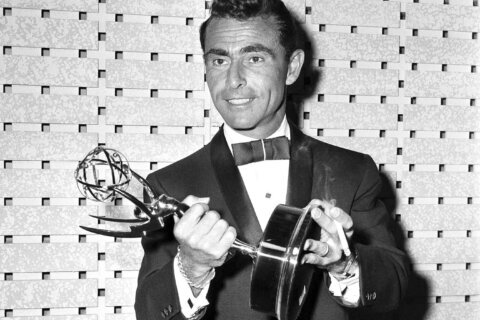Roy Orbison died of a heart attack at age 52 in 1988, while Buddy Holly was killed in a tragic plane crash at age 22 on “The Day the Music Died” in 1959.
But you can still watch them perform live in hologram with the “Rock ‘n Roll Dream Tour” at Strathmore in North Bethesda on Nov. 13.
“The effect is quite striking,” said David Hirshland, executive vice president of music publishing catalogs at BMG. “There’s lots of ‘oohs’ and ‘ahhs’ when Roy and Buddy appear on stage. It’s a fun show. You’re seeing as close to a Roy Orbison and Buddy Holly show as you possibly could get.”
A live band and backup singers join a hologram created by Base Entertainment.
“They didn’t develop the Tupac hologram, but once they saw the reaction to it, they thought this was something that made a lot of sense,” Hirshland said. “They approached the Roy Orbison estate and the estate was very happy to have Roy presented in this format. That show toured in Europe to great acclaim with a limited number of shows in the United States. They felt they needed to bolster the show with a second artist. They couldn’t think of a better artist than Buddy Holly.”
How exactly does the hologram technology work?
“The way it works is they choose an actor, much like you’ve seen actors in films, for example, Carrie Fisher in the ‘Star Wars’ films after she passed away, or Andy Serkis is also the perfect example,” Hirshland said. “You shoot the actor who is very much imitating the moves and look of Buddy Holly. You spend a lot of time in makeup, you shoot in a special camera, then afterwards do CGI work to further enhance the image to make it appear as if it’s really Buddy Holly.”
The posthumous performances present a new frontier for licensing and copyright.
“We at BMG obtained the rights to Buddy Holly’s catalog, name, image and likeness from [his widow] Maria Elena Holly back in 2015,” Hirshland said. “It’s like any other division of revenue in live music. Base needs to be reimbursed for their expenses and the artists’ estates have the benefit of being paid part of the net proceeds, as well as the songs. … The record label gets paid because they’re using the original masters [of] the voice that was originally recorded.”
Holly’s singing style remains iconic for his trademark vocal hiccups.
“Buddy’s way of singing was unique,” Hirshland said. “He invented so much of what rock ‘n roll became. Elvis Presley of course gets a lot of credit and deservingly so, but Buddy was the first guy that wrote his own songs, produced his own songs, put the four-instrument format together, which The Beatles adopted. Of course, The Beatles are named after Buddy’s group The Crickets. Even his way of singing influenced an entire generation of rock ‘n roll stars.”
He cranked out an unreal number of hits in a short period of time with “Everyday,” “That’ll Be the Day,” “Peggy Sue,” “Rave On,” “Maybe Baby” and “Oh, Boy.”
“People are going to be astounded and realize that every song is a hit,” Hirshland said. “Buddy wrote 46 songs in an 18-month period and nearly all of them were hits. … You’ve got so many songs that have become standards that have been covered over and over again. We just licensed ‘Everyday’ to Citibank for a new campaign, Fiona Apple’s version, you’ve got the Linda Ronstadt cover, the Grateful Dead closed their show for years with a Buddy Holly song, and the first song The Beatles ever played in their audition was ‘Crying, Waiting, Hoping.'”
Holly’s untimely death left so much unfinished.
“Buddy Holly was tragically lost to us at the age of 22 in 1959, so obviously very few people alive today got to see Buddy Holly perform,” Hirshland said. “The James Dean effect [means] we’ll always think of Buddy as forever young and a hero and just a tragic loss. You think about what he did in such a short period of time and what he could have accomplished. He was set to record with Ray Charles, Mahalia Jackson, he had a lot of plans that went beyond rock ‘n roll.”
In addition to Buddy Holly, audiences will also get to see Roy Orbison.
“Obviously, many many more people got to see Roy, there was a very big television special he did, and he was a member of the supergroup with George Harrison, Bob Dylan and Tom Petty, so Roy had a full career,” Hirshland said.
His voice remains as iconic as Holly’s.
“That instrument is incredible,” Hirshland said. “You think of the falsetto that Roy had. It was unique. He was one of the greatest vocalists in rock ‘n roll history.”
Orbison was a prolific hitmaker with “Only the Lonely,” “Running Scared,” “Crying,” “In Dreams,” “Oh, Pretty Woman” and “(Anything You Want) You Got It.”
“You’re going to get an interesting mix of Roy’s mournful, sad songs and Buddy’s celebratory jubilant songs,” Hirshland said. “The show is so interesting because these guys are both from West Texas, they knew each other but they never performed together and now they get to share the stage together.”
The special setup is great for grandparents, parents and kids to enjoy.
“We’ve seen all ages at these shows,” Hirshland said. “Kids are not only interested in exploring the artists, but they seem to be more interested in the technology. … The kids are particularly interested in this new form. The adults may think they’re just going to an oldies rock ‘n roll show, which they are, but the kids are reacting to everything and it’s really fascinating to see that.”
Does he imagine this technology expanding to other artists in the future?
“I have no doubt,” Hirshland said. “It depends on what the estates want to do of these various artists, but Base is already in production on a Whitney Houston show that will be much different. They’ve done Maria Callas, so they’ve done the classical opera world. There’s currently a Frank Zappa hologram that’s been produced, there’s a Ronnie James Dio. Absolutely no question this will be a more common form of entertainment, especially as we keep losing great artists.”
Find out more on the Strathmore website. Hear our full conversation below:








